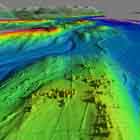
Left: Galway Bay seabed
In announcing the conference, Minister of State at the Communications, Energy and Natural Resources, Conor Lenihan, TD, commented “Ireland leads the way in global marine science and seabed mapping and this conference will showcase our achievements to date. At a time of financial difficulties it is crucial that such projects can be demonstrated to have a significant fiscal benefit to the state and I welcome the findings of a PricewaterhouseCoopers report on INFOMAR showing a return of over four times the cost.” The benefits accrue across a range of sectors from fishing, tourism and energy, to compliance with international legislation and the research sector. The study, as well as tangible examples of real benefits to the state, will be presented at the conference.
The state’s latest research vessel the RV Keary, a dedicated inshore mapping launch, will also be named during the conference. The vessel is a 15 metre aluminium catamaran, purpose-built for inshore mapping with state of the art technology. Amongst her best attributes is her ability to deliver exceptional depth accuracy, vital for safe transport and offshore development and protection. She is named after the late Raymond Keary, distinguished Irish marine geologist who had the vision of a national marine mapping project. According to Minister Lenihan, “in commissioning the new vessel, Keary, we will also see cost effective mapping of our shallowest waters and a valuable addition to our national research capacity.”
One project based on seabed mapping results, jointly carried out by GSI, MI and the National Parks and Wildlife Service, has just returned from deepwater filming of coral reefs on parts of the Rockall Bank for the very first time. This study will assist the process of designation of new offshore Special Areas of Conservation.
The Conference will take place at Liberty Hall in Dublin on October 5th and 6th, with the vessel-naming at Poolbeg Marina on Tuesday evening at 5.45 and interested parties can register here
































































